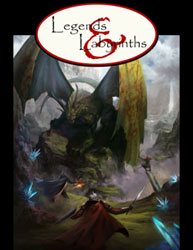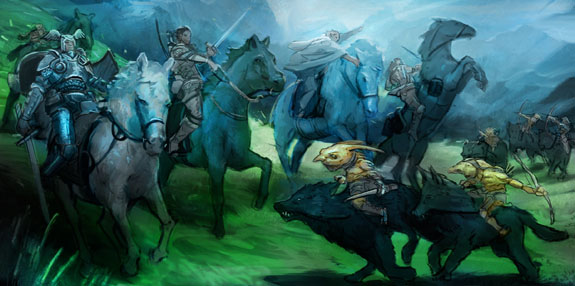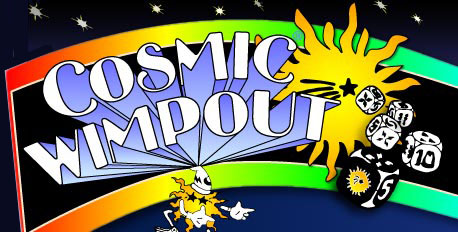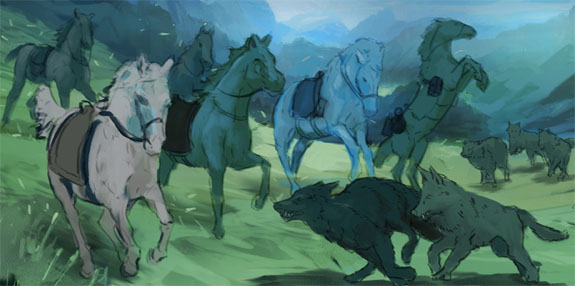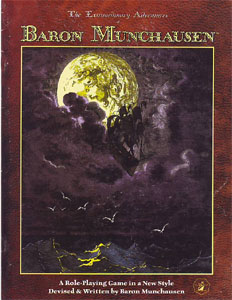 Tagline: The hit of GenCon ’98. The hit of your gaming table.
Tagline: The hit of GenCon ’98. The hit of your gaming table.
I know I used this word just last week, but I’m afraid I need to use it again: Unique.
The Extraordinary Adventures of Baron Munchausen is a unique, high quality product. In twenty-four pages James Wallis – excuse me, Baron Munchausen has created one of the most memorable game manuals I’ve ever read. Hell, I’ll even go so far as to say it was one of the most memorable experiences I’ve ever had, period.
(Allow me to slip into the idiom of the game itself.)
The game was designed by the famous Baron Munchausen himself in the year 1798 while staying with a friend of his, the publisher John Wallis, in London. After receiving the manuscript – one of the most expensive he had ever paid for (the Baron had a habit of going through the best liquor in anyone’s house) – Mr. Wallis realized that the manuscript was simply unacceptable for its time period. Instead he sealed the manuscript until such time as one of his descendants thought the time was finally right to release it. His descendent James Wallis, the current director of Hogshead Publishing, has finally decided that such a time has come and has released the game on its 200th anniversary.
(Yeah, right.)
The game basically breaks down like this: You get together with a number of other compatriots (making sure to keep the number of commoners down to a minimum) and gather around a table at your favorite bar. Make sure you bring your purses and a good supply of coins because wagering will be involved (the Baron points out that all the coins should be of the same value in order to keep arguments to a minimum). The game begins when one of you turns to another and says, “So, Baron, tell us of the occasion when you gave birth to an elephant.” (Or some other outrageous circumstance.)
At this point the person may either say, “Ah yes, of course…” And begin to tell his tale. Otherwise he may say, “No, I’m afraid my throat is dry…” At which point he must buy a round of drinks for everyone else in his party and ask the person next to him tell a tale of his own.
During the telling of the tale others may interrupt the storyteller with objections such as, “But, Baron de Neuvillette, it is well known that the fire-breathing llamas on the moon are strict vegetarians.” (The key here is that these are potentially amusing complications, not serious nit-picks.) When doing this the objector pushes forward a coin from their purse. The storyteller may then accept the objection (“Ah, yes, but this llama was merely fetching food for the young wolf cub she had taken under the fold of her wing…”) and take the wagered coin. Otherwise the storyteller must put forth a coin of his own and decline the objection (“You must be thinking of the goats to be found upon the moons of Venus, for it is well known that the llamas of the moon are of no such character…”). The objector may either take both coins on the table, or he may add a third coin and renew his objection.
That is the basic mechanic of the game. There is also dueling, companions, methods of finishing a story, various drinking rituals, and (finally) the wrap-up of each round of storytelling. The book itself also includes an appendix with over two hundred suggestions for stories and another appendix which sums up the rules on a single page (which is useful since the Baron does tend to ramble in a thoroughly enjoyable manner).
(Okay, so why should you buy it?)
First off, the game is just plain fun to play. Swapping the outrageous stories which form the centerpiece of the game is great. Add on the ritualized drinking which is incorporated into the game (plus the elaborate wagering system which – in the end – makes no one and everyone a winner) and you’ve got an irresistible night’s entertainment.
Second, the book is a treat to read. It is written in the voice of the inestimable Baron himself. He is constantly wandering off the main track of the narrative in order to recount various snippets of his own outrageous tales (although none should doubt the honesty of his own stories, for he would take offense at this insult to his honor). The illustrations are by Gustave Dore, the “greatest illustrator of the nineteenth century”, who died in 1883 (I really hope I can trust this section of the book).
(Coincidentally the Baron himself died in 1797, which is revealed in his biography in the back of the book. Leave it to the Baron to write a game about himself the year after he died.)
Finally, the title of the game is no joke: This is truly a “Role-Playing Game in a New Style”. Wait a minute, you say, nothing that you’ve described sounds like the roleplaying games I know.
Well, duh. It’s in a new style!
Let’s break it down. First, it definitely involves roleplaying: Namely you assume a character who is inspired by the Baron Munchausen himself. You may find this limiting at first, but then I realized that the only important thing here is the element of your character which involves being the type of person who goes on outrageous adventures and then tells stories about them. Beyond that things are pretty wide open. I don’t consider that any more restricting than being told to “design a character who will go on fantasy adventures” or “design a character who happens to be a vampire”. Plus you get to play the character at two levels simultaneously (something “traditional” roleplaying games don’t let you do) – both at the immediate level of “telling the story” and in the events of the story being told.
Second, it’s definitely a game. What makes this unique is that inherits a different tradition than other roleplaying games do. Most RPGs stem from the traditions of wargames and boardgames. The game elements of Baron Munchausen are derived more from card games – involving bidding and wagering.
The Extraordinary Adventures of Baron Munchausen is definitely a game you should buy. It was the hit of GenCon ’98, and it’ll be a hit at your game table… or, heck, the bar you go out to have a drink at afterwards.
[ Make sure you read the disclaimer on the title page. The quotes on the back are good, too. Save the “Table of Contents” for last, as some of the comments foreshadow pleasant jokes in the text; but definitely make time for it after finishing the book. Be warned that “you will require pencil, paper, imagination, a manservant, money, a selection of fine wines, noble blood, a sense of flamboyance, and at least one attractive member of the opposite sex (optional).” ]
[ I have been informed that the game was actually conceived in 1792 or 1793, with the explanation of its existence being written in 1798. Which is, of course, unfortunate because it ruins the perfectly good joke found above. In the interests of absolute accuracy I have, of course, attached this note to clarify my earlier mistake. ]
Style: 5
Substance: 5
Author: Baron Munchausen (James Willis)
Company/Publisher: Hogshead Publishing
Cost: $5.95
Page count: 24
ISBN: 1-899749-18-7
Originally Posted: 1999/05/28
At the time this review appeared, there was a massive debate raging at RPGNet concerning whether or not The Extraorindary Adventures of Baron Munchausen qualified as a roleplaying game or not. You can see my thoughts on the matter, circa-1999, above.
Today, my opinion on the matter would be quite different.
The discussions surrounding Baron Munchausen in 1999 caused me to formulate my definition of an RPG as “a game which involves roleplaying”. Applying the definition gave a clear-cut verdict in favor of Baron Munchausen, case closed.
But not really. Because when I found myself applying that definition beyond the confines of that narrow debate, it quickly became apparent that its semi-circular nature was only part of the problem: It also created far too many false positive, reporting that everything from Risk to Super Mario Bros. was a roleplaying game.
It took several more years before I evolved a better definition of “roleplaying game” that accurately encapsulated the history of the medium without simultaneously including a bunch of other games that clearly weren’t RPGs. You can read more about that in Roleplaying Games vs. Storytelling Games. (The Extraordinary Adventures of Baron Munchausen, for the record, is an STG, not an RPG.)
For an explanation of where these reviews came from and why you can no longer find them at RPGNet, click here.


